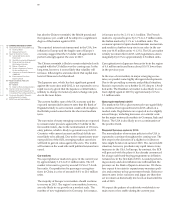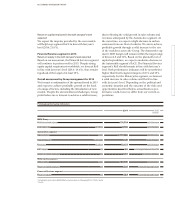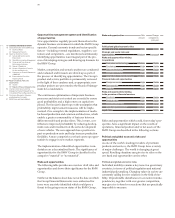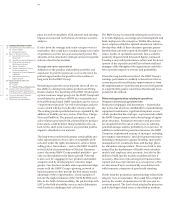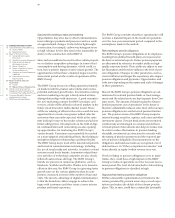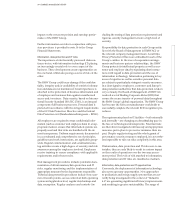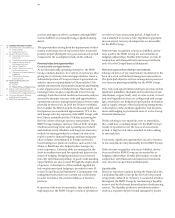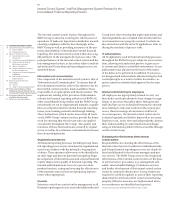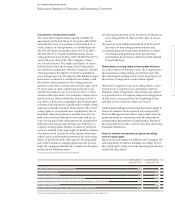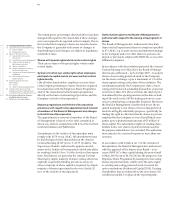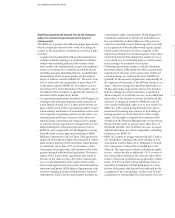BMW 2014 Annual Report Download - page 75
Download and view the complete annual report
Please find page 75 of the 2014 BMW annual report below. You can navigate through the pages in the report by either clicking on the pages listed below, or by using the keyword search tool below to find specific information within the annual report.
75 COMBINED MANAGEMENT REPORT
Production and technology-related opportunities
In addition to the risks involved, we firmly believe that
the choice of sites for new production facilities also
creates a wealth of opportunities. Selecting a new loca-
tion goes hand in glove with the opportunity to shape
the local environment in a positive way (e. g. job crea-
tion, training, corporate social responsibility (CSR) pro-
jects). Our aim is to continue our commitment to sus-
tainability whenever a new site is selected. We therefore
endeavour to incorporate flagship projects at our pro-
duction sites that have a clear focus on sustainability
(e. g. wind turbines in Leipzig). The option of offsetting
capacities between BMW Group sites is always kept in
mind if production technologies can be employed to
achieve greater efficiency in the use of resources.
Compared to the outlook, efficiency improvements are
unlikely to have a significantly greater impact over
the two-year assessment period than that already incor-
porated in the outlook.
Purchasing risks
Close cooperation between carmakers and automotive
suppliers creates economic benefits on the one hand,
but also raises levels of dependency on the other. The
increasing trend towards modular-based production
with a set of common architectures covering various
models and product lines exacerbates the consequences
of the loss of a supplier or failure to supply on time.
As part of the supplier preselection process, the BMW
Group is careful to ensure that its future business part-
ners meet the same high ecological, social and corpo-
rate governance standards by which the BMW Group is
generally measured. Suppliers are assessed on the basis
of the BMW Group Sustainability Standard, which is
applied throughout our supplier network worldwide.
This set of fundamental principles and standards covers
both production and non-production aspects relevant
for the goods and services provided by suppliers, which
also includes compliance with internationally recognised
human rights and applicable labour and social
stand-
ards. The principal tool for ensuring compliance with
the
BMW Group Sustainability Standard is a
three-
stage s
ustainability and risk management approach com-
prising
a BMW Group-specific sustainability risk filter,
a sustainability questionnaire and a sustainability audit.
In addition, the technical and financial capabilities of
suppliers – especially those supplying for modularbased
production – are continuously monitored during both
the development and production phases of the Group’s
vehicles. Particular attention is paid to the quality of the
parts. In order to attain the level of quality required, it
may become necessary to invest in new technological
concepts or discontinue planned innovations, with the
consequence that the cost of materials could exceed
levels incorporated in the outlook. Supplier sites are as-
sessed for exposure to natural hazards, such as floods
or earthquakes, in order to identify supply risks at an
early stage and implement appropriate countermeasures.
Production problems incurred by suppliers could have
adverse consequences for the BMW Group, ranging
from increased expenditure through to production in-
terruptions and a corresponding reduction in sales
volume.
Raw materials management procedures are in place to
mitigate the risk of a production interruption due to
shortages of supplies of critical raw materials. In order
to reduce supply risks, the BMW Group works hard
to reduce the input of raw materials or to use alternative
raw materials as a substitute.
If purchasing risks were to materialise, they could have
a high impact on the BMW Group’s results of opera-
tions over the two-year assessment period. The level
of
risk attached to supply risks is classified as high,
mainly due to the insufficient availability of raw materials
in Asia.
Risks relating to sales and marketing
Changes in global economic conditions and increasingly
protectionist trends are among the factors that could
result in lower demand as well as fluctuations in the re-
gional spread and composition of sales in terms of
vehi-
cles and mobility services. Risks relating to these
developments can be reduced with the aid of flexible
selling and production processes. At the same time,
in-
creased pressure on selling prices and margins caused
by intense competition on the world’s markets, particu-
larly in Western Europe, the USA and China, requires
constant analysis, including keeping an eye on develop-
ments in grey market volumes from the USA to China.
Selling price and margin risks are determined on the
basis of past experience and changing global economic
conditions, with risk exposures measured using a cash-
flow-at-risk model.
If sales and marketing risks were to materialise, they
could have a
high
impact on the BMW Group’s results
of operations over the two-year
assessment period. The
level of risk attached to sales and
marketing risks is
classified as high.



